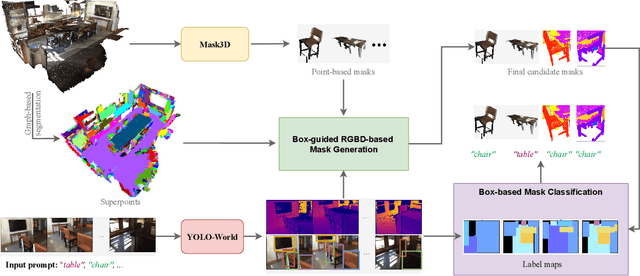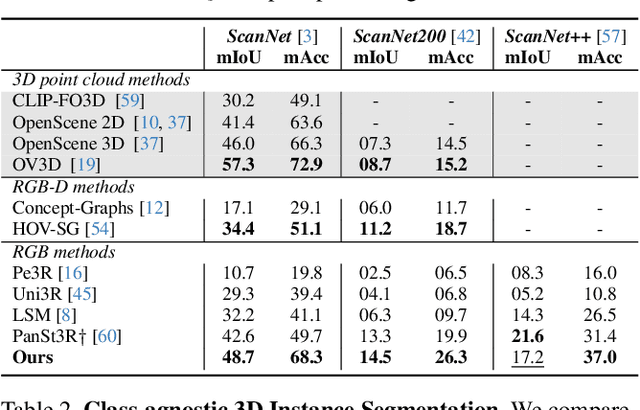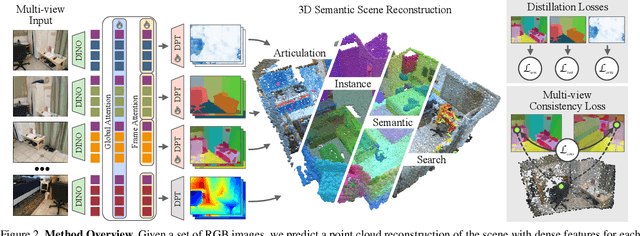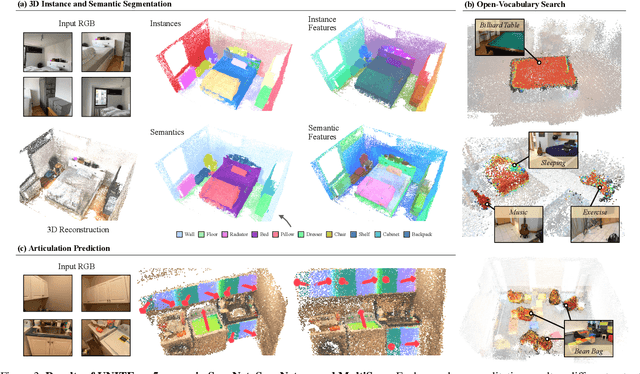3D Instance Segmentation
3D instance segmentation is the process of identifying and segmenting individual objects in 3D point clouds or scenes.
Papers and Code
Systematic Evaluation of Depth Backbones and Semantic Cues for Monocular Pseudo-LiDAR 3D Detection
Jan 07, 2026Monocular 3D object detection offers a low-cost alternative to LiDAR, yet remains less accurate due to the difficulty of estimating metric depth from a single image. We systematically evaluate how depth backbones and feature engineering affect a monocular Pseudo-LiDAR pipeline on the KITTI validation split. Specifically, we compare NeWCRFs (supervised metric depth) against Depth Anything V2 Metric-Outdoor (Base) under an identical pseudo-LiDAR generation and PointRCNN detection protocol. NeWCRFs yields stronger downstream 3D detection, achieving 10.50\% AP$_{3D}$ at IoU$=0.7$ on the Moderate split using grayscale intensity (Exp~2). We further test point-cloud augmentations using appearance cues (grayscale intensity) and semantic cues (instance segmentation confidence). Contrary to the expectation that semantics would substantially close the gap, these features provide only marginal gains, and mask-based sampling can degrade performance by removing contextual geometry. Finally, we report a depth-accuracy-versus-distance diagnostic using ground-truth 2D boxes (including Ped/Cyc), highlighting that coarse depth correctness does not fully predict strict 3D IoU. Overall, under an off-the-shelf LiDAR detector, depth-backbone choice and geometric fidelity dominate performance, outweighing secondary feature injection.
CropNeRF: A Neural Radiance Field-Based Framework for Crop Counting
Jan 01, 2026Rigorous crop counting is crucial for effective agricultural management and informed intervention strategies. However, in outdoor field environments, partial occlusions combined with inherent ambiguity in distinguishing clustered crops from individual viewpoints poses an immense challenge for image-based segmentation methods. To address these problems, we introduce a novel crop counting framework designed for exact enumeration via 3D instance segmentation. Our approach utilizes 2D images captured from multiple viewpoints and associates independent instance masks for neural radiance field (NeRF) view synthesis. We introduce crop visibility and mask consistency scores, which are incorporated alongside 3D information from a NeRF model. This results in an effective segmentation of crop instances in 3D and highly-accurate crop counts. Furthermore, our method eliminates the dependence on crop-specific parameter tuning. We validate our framework on three agricultural datasets consisting of cotton bolls, apples, and pears, and demonstrate consistent counting performance despite major variations in crop color, shape, and size. A comparative analysis against the state of the art highlights superior performance on crop counting tasks. Lastly, we contribute a cotton plant dataset to advance further research on this topic.
UniC-Lift: Unified 3D Instance Segmentation via Contrastive Learning
Dec 31, 20253D Gaussian Splatting (3DGS) and Neural Radiance Fields (NeRF) have advanced novel-view synthesis. Recent methods extend multi-view 2D segmentation to 3D, enabling instance/semantic segmentation for better scene understanding. A key challenge is the inconsistency of 2D instance labels across views, leading to poor 3D predictions. Existing methods use a two-stage approach in which some rely on contrastive learning with hyperparameter-sensitive clustering, while others preprocess labels for consistency. We propose a unified framework that merges these steps, reducing training time and improving performance by introducing a learnable feature embedding for segmentation in Gaussian primitives. This embedding is then efficiently decoded into instance labels through a novel "Embedding-to-Label" process, effectively integrating the optimization. While this unified framework offers substantial benefits, we observed artifacts at the object boundaries. To address the object boundary issues, we propose hard-mining samples along these boundaries. However, directly applying hard mining to the feature embeddings proved unstable. Therefore, we apply a linear layer to the rasterized feature embeddings before calculating the triplet loss, which stabilizes training and significantly improves performance. Our method outperforms baselines qualitatively and quantitatively on the ScanNet, Replica3D, and Messy-Rooms datasets.
SOFTooth: Semantics-Enhanced Order-Aware Fusion for Tooth Instance Segmentation
Dec 29, 2025Three-dimensional (3D) tooth instance segmentation remains challenging due to crowded arches, ambiguous tooth-gingiva boundaries, missing teeth, and rare yet clinically important third molars. Native 3D methods relying on geometric cues often suffer from boundary leakage, center drift, and inconsistent tooth identities, especially for minority classes and complex anatomies. Meanwhile, 2D foundation models such as the Segment Anything Model (SAM) provide strong boundary-aware semantics, but directly applying them in 3D is impractical in clinical workflows. To address these issues, we propose SOFTooth, a semantics-enhanced, order-aware 2D-3D fusion framework that leverages frozen 2D semantics without explicit 2D mask supervision. First, a point-wise residual gating module injects occlusal-view SAM embeddings into 3D point features to refine tooth-gingiva and inter-tooth boundaries. Second, a center-guided mask refinement regularizes consistency between instance masks and geometric centroids, reducing center drift. Furthermore, an order-aware Hungarian matching strategy integrates anatomical tooth order and center distance into similarity-based assignment, ensuring coherent labeling even under missing or crowded dentitions. On 3DTeethSeg'22, SOFTooth achieves state-of-the-art overall accuracy and mean IoU, with clear gains on cases involving third molars, demonstrating that rich 2D semantics can be effectively transferred to 3D tooth instance segmentation without 2D fine-tuning.
3D sans 3D Scans: Scalable Pre-training from Video-Generated Point Clouds
Dec 28, 2025Despite recent progress in 3D self-supervised learning, collecting large-scale 3D scene scans remains expensive and labor-intensive. In this work, we investigate whether 3D representations can be learned from unlabeled videos recorded without any real 3D sensors. We present Laplacian-Aware Multi-level 3D Clustering with Sinkhorn-Knopp (LAM3C), a self-supervised framework that learns from video-generated point clouds from unlabeled videos. We first introduce RoomTours, a video-generated point cloud dataset constructed by collecting room-walkthrough videos from the web (e.g., real-estate tours) and generating 49,219 scenes using an off-the-shelf feed-forward reconstruction model. We also propose a noise-regularized loss that stabilizes representation learning by enforcing local geometric smoothness and ensuring feature stability under noisy point clouds. Remarkably, without using any real 3D scans, LAM3C achieves higher performance than the previous self-supervised methods on indoor semantic and instance segmentation. These results suggest that unlabeled videos represent an abundant source of data for 3D self-supervised learning.
Retrieving Objects from 3D Scenes with Box-Guided Open-Vocabulary Instance Segmentation
Dec 22, 2025



Locating and retrieving objects from scene-level point clouds is a challenging problem with broad applications in robotics and augmented reality. This task is commonly formulated as open-vocabulary 3D instance segmentation. Although recent methods demonstrate strong performance, they depend heavily on SAM and CLIP to generate and classify 3D instance masks from images accompanying the point cloud, leading to substantial computational overhead and slow processing that limit their deployment in real-world settings. Open-YOLO 3D alleviates this issue by using a real-time 2D detector to classify class-agnostic masks produced directly from the point cloud by a pretrained 3D segmenter, eliminating the need for SAM and CLIP and significantly reducing inference time. However, Open-YOLO 3D often fails to generalize to object categories that appear infrequently in the 3D training data. In this paper, we propose a method that generates 3D instance masks for novel objects from RGB images guided by a 2D open-vocabulary detector. Our approach inherits the 2D detector's ability to recognize novel objects while maintaining efficient classification, enabling fast and accurate retrieval of rare instances from open-ended text queries. Our code will be made available at https://github.com/ndkhanh360/BoxOVIS.
MoonSeg3R: Monocular Online Zero-Shot Segment Anything in 3D with Reconstructive Foundation Priors
Dec 17, 2025In this paper, we focus on online zero-shot monocular 3D instance segmentation, a novel practical setting where existing approaches fail to perform because they rely on posed RGB-D sequences. To overcome this limitation, we leverage CUT3R, a recent Reconstructive Foundation Model (RFM), to provide reliable geometric priors from a single RGB stream. We propose MoonSeg3R, which introduces three key components: (1) a self-supervised query refinement module with spatial-semantic distillation that transforms segmentation masks from 2D visual foundation models (VFMs) into discriminative 3D queries; (2) a 3D query index memory that provides temporal consistency by retrieving contextual queries; and (3) a state-distribution token from CUT3R that acts as a mask identity descriptor to strengthen cross-frame fusion. Experiments on ScanNet200 and SceneNN show that MoonSeg3R is the first method to enable online monocular 3D segmentation and achieves performance competitive with state-of-the-art RGB-D-based systems. Code and models will be released.
Unified Semantic Transformer for 3D Scene Understanding
Dec 18, 2025



Holistic 3D scene understanding involves capturing and parsing unstructured 3D environments. Due to the inherent complexity of the real world, existing models have predominantly been developed and limited to be task-specific. We introduce UNITE, a Unified Semantic Transformer for 3D scene understanding, a novel feed-forward neural network that unifies a diverse set of 3D semantic tasks within a single model. Our model operates on unseen scenes in a fully end-to-end manner and only takes a few seconds to infer the full 3D semantic geometry. Our approach is capable of directly predicting multiple semantic attributes, including 3D scene segmentation, instance embeddings, open-vocabulary features, as well as affordance and articulations, solely from RGB images. The method is trained using a combination of 2D distillation, heavily relying on self-supervision and leverages novel multi-view losses designed to ensure 3D view consistency. We demonstrate that UNITE achieves state-of-the-art performance on several different semantic tasks and even outperforms task-specific models, in many cases, surpassing methods that operate on ground truth 3D geometry. See the project website at unite-page.github.io
Chorus: Multi-Teacher Pretraining for Holistic 3D Gaussian Scene Encoding
Dec 22, 2025While 3DGS has emerged as a high-fidelity scene representation, encoding rich, general-purpose features directly from its primitives remains under-explored. We address this gap by introducing Chorus, a multi-teacher pretraining framework that learns a holistic feed-forward 3D Gaussian Splatting (3DGS) scene encoder by distilling complementary signals from 2D foundation models. Chorus employs a shared 3D encoder and teacher-specific projectors to learn from language-aligned, generalist, and object-aware teachers, encouraging a shared embedding space that captures signals from high-level semantics to fine-grained structure. We evaluate Chorus on a wide range of tasks: open-vocabulary semantic and instance segmentation, linear and decoder probing, as well as data-efficient supervision. Besides 3DGS, we also test Chorus on several benchmarks that only support point clouds by pretraining a variant using only Gaussians' centers, colors, estimated normals as inputs. Interestingly, this encoder shows strong transfer and outperforms the point clouds baseline while using 39.9 times fewer training scenes. Finally, we propose a render-and-distill adaptation that facilitates out-of-domain finetuning. Our code and model will be released upon publication.
Deep Learning Perspective of Scene Understanding in Autonomous Robots
Dec 16, 2025This paper provides a review of deep learning applications in scene understanding in autonomous robots, including innovations in object detection, semantic and instance segmentation, depth estimation, 3D reconstruction, and visual SLAM. It emphasizes how these techniques address limitations of traditional geometric models, improve depth perception in real time despite occlusions and textureless surfaces, and enhance semantic reasoning to understand the environment better. When these perception modules are integrated into dynamic and unstructured environments, they become more effective in decisionmaking, navigation and interaction. Lastly, the review outlines the existing problems and research directions to advance learning-based scene understanding of autonomous robots.
 Add to Chrome
Add to Chrome Add to Firefox
Add to Firefox Add to Edge
Add to Edge